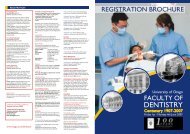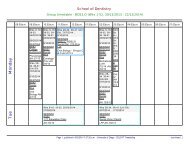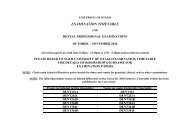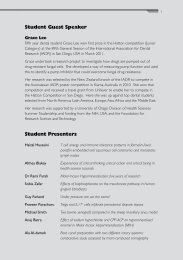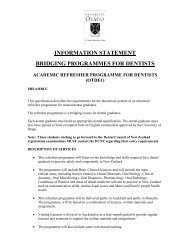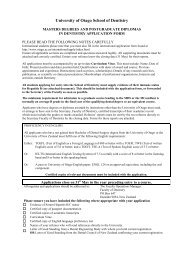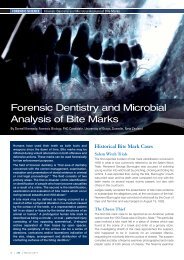2OO9 – 2O1O - Faculty of Dentistry - University of Otago
2OO9 – 2O1O - Faculty of Dentistry - University of Otago
2OO9 – 2O1O - Faculty of Dentistry - University of Otago
You also want an ePaper? Increase the reach of your titles
YUMPU automatically turns print PDFs into web optimized ePapers that Google loves.
KYOKO NIIMI<br />
DVM (Nihon Vet) PhD (<strong>Otago</strong>)<br />
Oral Sciences<br />
Senior Research Fellow<br />
Dr Niimi’s research interests are in microbiology/<br />
mycology research and the development <strong>of</strong> antifungal<br />
agents, with three main areas <strong>of</strong> research expertise: the<br />
molecular biology <strong>of</strong> human fungal pathogens Candida<br />
albicans and C. glabrata; the mechanisms <strong>of</strong> antifungal<br />
resistance and drug development; and heterologous<br />
protein expression in the yeast Saccharomyces cerevisiae.<br />
Research and Collaboration<br />
Dr Niimi’s research scope in 2009 and 2010 was tw<strong>of</strong>old.<br />
Investigating mechanisms <strong>of</strong> echinocandin resistance in<br />
human fungal pathogens Candida albicans and C. glabrata.<br />
A novel class <strong>of</strong> antifungal agent, the echinocandins,<br />
provides new therapeutic options for the treatment <strong>of</strong><br />
fungal infections caused by Candida species. The incidence<br />
<strong>of</strong> echinocandin resistance remains low; however, there<br />
are some reports <strong>of</strong> echinocandin resistant isolates<br />
from patients with treatment failure. It was found that<br />
mutations in two alleles <strong>of</strong> diploid C. albicans and two<br />
separate genes <strong>of</strong> haploid C. glabrata are required for the<br />
acquisition <strong>of</strong> high-level resistance, which may be why<br />
clinically significant echinocandin resistance is rare. Key<br />
collaborators in the project include Drs K. Maki and K.<br />
Hatakenaka <strong>of</strong> Astellas Pharma Inc., Japan; Assoc. Pr<strong>of</strong>. H.<br />
Nakayama, Suzuka <strong>University</strong> <strong>of</strong> Medical Sciences, Japan;<br />
Assoc. Pr<strong>of</strong>. H. Chibana and Dr K. Ueno, Chiba <strong>University</strong>,<br />
Japan; Drs A. Hirai, T. Umeyama, K. Tanabe and Niimi, M.,<br />
National Institute <strong>of</strong> Infectious Diseases, Japan; Drs B.<br />
C. Monk, Woods, M. A. and Pr<strong>of</strong>. R. D. Cannon <strong>of</strong> the<br />
Molecular Microbiology Laboratory, <strong>University</strong> <strong>of</strong> <strong>Otago</strong>.<br />
Modifying the heterologous membrane expression<br />
system to maximize protein expression. The heterologous<br />
membrane expression system in baker’s yeast was<br />
developed in the Molecular Microbiology Laboratory<br />
(MML). The system needs to be further improved to<br />
achieve high level expression <strong>of</strong> human membrane proteins<br />
(such as Abcb1p, Abcg2p or Abcb5p) that are involved<br />
in drug resistance in human cancer cells. Mutant cells<br />
were selected which possessed higher drug efflux activity,<br />
by UV irradiation followed by genetic engineering. Key<br />
collaborators include Pr<strong>of</strong>essor R. D. Cannon, Drs B. C.<br />
Monk, M. Niimi, E. Lamping, A. R. Holmes, M. Keniya <strong>of</strong> MML;<br />
Assoc Pr<strong>of</strong>. S. Kajiwara, Tokyo Institute <strong>of</strong> Technology, Japan.<br />
46 FACULTY OF DENTISTRY RESEARCH REPORT 2009-2010<br />
Recent Publications<br />
Niimi K, Monk BC, Hirai A, Hatakenaka K, Umeyama T,<br />
Lamping E, Maki K, Tanabe K, Kamimura T, Ikeda F, Uehara<br />
Y, Kano R, Hasegawa A, Cannon RD, Niimi M. Clinically<br />
significant micafungin-resistance in Candida albicans<br />
involves modification <strong>of</strong> a glucan synthase catalytic subunit<br />
GSC1 (FKS1) allele followed by loss <strong>of</strong> heterozygosity.<br />
Journal <strong>of</strong> Antimicrobial Chemotherapy 65: 842-852 (2010).<br />
Cannon RD, Lamping E, Holmes AR, Niimi K, Baret PV,<br />
Keniya MV, Tanabe K, Niimi M, G<strong>of</strong>feau A, Monk BC.<br />
Efflux-mediated fungal drug resistance. Clinical Microbiology<br />
Reviews 22: 291-321 (2009).<br />
Lamping E, Ranchod A, Nakamura K, Tyndall JDA, Niimi K,<br />
Holmes AR, Niimi M, Cannon RD. Abc1p is a multidrug<br />
efflux transporter that tips the balance in favor <strong>of</strong> innate<br />
azole resistance in Candida krusei. Antimicrobial Agents and<br />
Chemotherapy 53: 354-369 (2009).<br />
Niimi K, Niimi M. Mechanisms <strong>of</strong> echinocandin resistance<br />
in pathogenic fungi. Japanese Journal <strong>of</strong> Medical Mycology<br />
50: 57-66 (2009).



